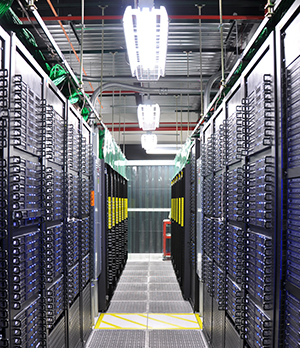Powering the Future of Communications
By: Ryan Baumann

As the digital economy’s dependence on data grows more intense by the day, the information storage and connectivity that data centers provide is becoming inextricably tied to day-to-day success—for communities, families, individuals, or businesses. The importance of the data center cannot be overstated: the global market is expected to grow by $519.34 billion from 2021-2025. When considering these crucial information hubs, standard systems like cooling, networking and physical security come to mind, all of which play an important part in the care and keeping of data. The overall viability of the data center hinges, however, on its ability to stay up, on and fully powered—regardless of what kind of disruptions may come its way.
As the importance of IT rises across the world, so too does the need to maintain uptime with the right equipment. If a data center loses power, a crucial facet of an organization’s growing connectivity fabric can be rendered unusable. Now, the cost of downtime is higher than ever, and data centers (and their tenants) are risking more across bottom lines, customer trust and operational capabilities should a system be compromised. It’s for this reason that the diesel generator is now one of the most important assets for a data center.
When utility power is gone, whether from disruptive weather, human error or any other unforeseen circumstance, continuity and uptime can be preserved through gensets. The UPSs, power chillers, cooling systems, and even the emergency egress systems that help employees operate safely in the facility, all need to be supported in the event of an outage. In short, secure space, storage, and connectivity—the pillars of the data center and networking experience—are only as capable as the power that enables them. The genset can be the tool that empowers all elements of the data center to remain uninterrupted in the most critical moments.
Of course, these are the fundamental business continuity aspects that make gensets a necessity for data center providers. Still, there are a host of other reasons why making the most informed decision regarding the generator—and generator partner—can be what sets a data center apart. As we look toward a digital future that is rapidly scaling and factor in things such as sustainability, several other considerations come into play.
Technical table stakes
Deciding what generator product is right for the data center starts with a relatively simple need. All facility providers are looking for similar outputs: they want backup power to go on when it needs to. However, addressing this requirement from a technical deployment perspective comes down to several key elements.
Early-stage success in selecting a solution means ensuring the product is right-sized for the use case, which encompasses the data center’s needs today, as well as its long-term growth potential. Ensuring the right fit is imperative for supporting immediate fuel efficiency optimization and emissions outputs. Selecting based on current needs is a relatively intuitive decision but prepping for future power demands is trickier.
Today, many are opting for systems that are close-coupled with the utility, which helps enable data halls to grow as needed with more expandability compared to paralleling frameworks.
A modular solution is key for maintaining flexibility down the line as well. We can see this specifically when it comes to the idea of sustainability. Regulations on emissions are continuing to grow tighter as a focus on a green future becomes more acute—and making sure existing generator deployments can accept a compliant solution (think Tier 4 EPA compliance) is valuable.
While EPA Tier 4 solutions come from the factory with the tier-approved solution in place as a day-one added cost, they’re not adaptable in the field. As nitrogen oxide (NOx) or particulate emissions standards intensify, adding after treatments in the field is key, making a standard compliant solution better from the outset in many cases. We don’t know exactly what tomorrow holds on this green front, but we know change is coming as sustainability becomes a major motivator. Making sure the product is sound as-is while also allowing for iterations should be top of mind.
The above points are only scratching the surface of genset selection and technological specification. It’s a sometimes-complex process that doesn’t just take specs into account—it reconciles the specifications with evolving, forward-thinking plans. Not just any old backup generator will set a data center up for long-term success. There’s another side to this coin that just might hold the true key to getting the right solution from the onset.
Why customer service really makes a difference
In many ways, procuring a successful long-term generator solution means finding a provider that can meet a customer’s service needs before it meets the product needs. Identifying a partner that brings the right insight to the table—on top of the most innovative and robust products—and can ensure ongoing care is what makes all the difference. This partnership is what keeps a data center ahead of the curve, whether with disaster recovery and resilience or with sustainability and ongoing innovation.



















